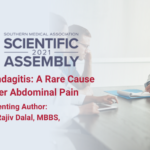Abstract | November 8, 2021
Epiploic Appendagitis: A Rare Cause of Left Lower Abdominal Pain
Learning Objectives
- Have a high suspicion of epiploic appendagitis in patients presenting with left lower quadrant abdominal pain for early diagnosis and treatment.
- Identify typical CT scan findings include a ring sign and central dot sign.
- Discuss epiploic appendagitis as a non-surgical cause of left lower quadrant abdominal pain.
Introduction: Epiploic appendages are normal outpouchings of peritoneal fat on the antimesenteric surface of the colon, sitting on a vascular stalk. Acute torsion or thrombosis of the central vein of long appendages followed by ischaemia and infarction leads to acute lower abdomen. Epiploic appendagitis is a rare, benign and self-limiting disease. It is often misdiagnosed as diverticulitis or appendicitis due to overlapping clinical features, leading to unnecessary hospitalisations and unwarranted surgical intervention. An early diagnosis of epiploic appendagitis based on characteristic imaging features can expedite the diagnosis and avoid hospitalization.
Case Presentation: Here we present a case of epiploic appendagitis in a 61-year-old woman who presented with a worsening one-week history of left lower quadrant abdominal pain. An abdominal X-ray and urinalysis did not show any acute abnormality. A complete blood cell count ruled out leukocytosis. She was started on ciprofloxacin and metronidazole empirically for possible diverticulitis.
Final Diagnosis: Given the severity of the pain, CT scan of the abdomen was performed which was consistent with a diagnosis of epiploic appendagitis.
Management: The patient was treated successfully with oral antibiotics and non-steroidal anti-inflammatory agents. Patient recovered with conservative management over the next few days.
Discussion: Epiploic appendagitis should be in the list of differential diagnosis in patients presenting with acute or subacute abdominal pain. Typical findings on CT abdomen include: ‘ring sign’ which is hyperattenuating ovoid lesion from fat density and ‘central dot sign’ from mild bowel wall thickening and a central high attenuation focus within the fatty lesion. A high index of clinical suspicion is required for timely diagnosis of epiploic appendagitis in order to alert the radiologist to look for characteristic signs on imaging study. An early diagnosis can prevent surgical intervention and a high cure rate is achievable with conservative management.

